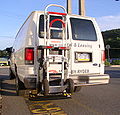2009 Ford E250 Cargo Quick Reference Safety Guide 1st Printing - Page 2
2009 Ford E250 Cargo Manual
Page 2 highlights
123910_09a_EseriesSafetyCard_022308.qxp:301309 Tweddle 5/6/08 2:54 PM Page 2 DRIVING Vans and wagons should be operated at a safe speed, which in some conditions may be less than the posted speed limit. Safety belts must be used by all occupants. • 80% of people fatally injured in rollover crashes involving all vehicle types were not wearing safety belts. • Passengers can dramatically reduce their risk of being killed or seriously injured in a crash by using their safety belts. • Organizations that own vans and wagons should have a written safety belt use policy. • Drivers should be responsible for enforcing the policy. Drivers must be well-rested, alert and maintain a safe speed for weather and road conditions. Drivers must be especially cautious on curved roads and maintain a safe speed to avoid running off the road. If the vehicle's wheels proceed off the roadway, gradually reduce speed and steer back onto the roadway when it is safe to do so. Avoid abrupt maneuvers to return the vehicle to the roadway. In the event of a flat tire or tread separation, gradually slow down the vehicle and avoid abrupt maneuvers. Because vans and wagons are substantially longer, wider and heavier than cars, they: • Require more space and additional reliance on the sideview mirrors for changing lanes. • Do not respond as quickly to abrupt steering maneuvers. • Require additional braking time and distance. An organization that owns an extended length van or wagon should select one or two experienced drivers to drive the vehicle on a regular basis to ensure the safety of each trip. LOADING This van or wagon, like any vehicle designed to carry very heavy loads, must be driven differently from a passenger car. The extra weight can affect stopping distance and maneuverability. The higher center of gravity and other features may reduce the ability to make abrupt maneuvers and may increase the risk of rollover compared to a passenger car. Do not place any loads on the roof of passenger wagons. This raises the center of gravity, which increases the risk of rollover. When loading your wagon, passengers should fill the front rows of seats first. The number of occupants in the vehicle should not exceed the number of available safety belt restraint systems. Do not exceed the weight limits specified on the certification label. Exceeding any vehicle weight rating limitation could result in serious damage to the vehicle, loss of vehicle control, vehicle rollover and/or personal injury. Please refer to your Owner's Guide for additional important information on vehicle weight limits. Towing trailers beyond the maximum recommended gross trailer weight could result in a loss of vehicle control, vehicle rollover and personal injury. Please refer to your Owner's Guide for more information on towing.






